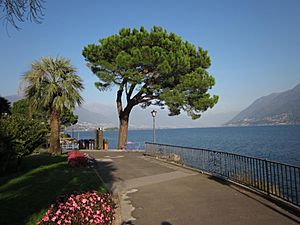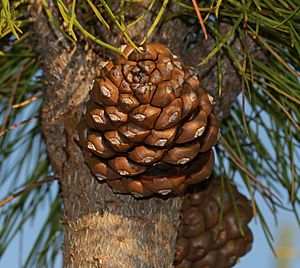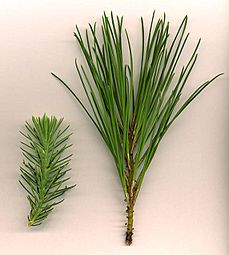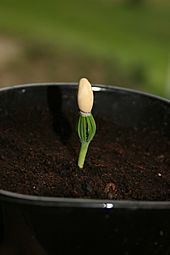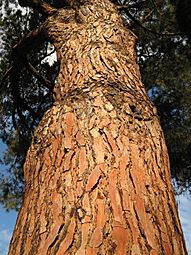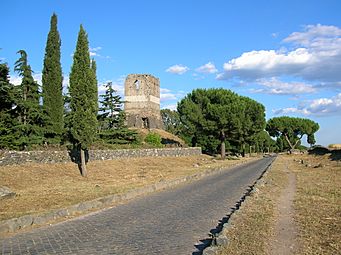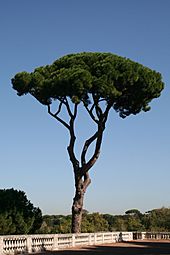Stone pine facts for kids
Quick facts for kids Stone pine |
|
|---|---|
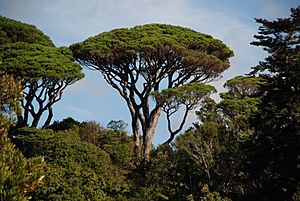 |
|
| Conservation status | |
| Scientific classification | |
| Genus: |
Pinus
|
| Species: |
pinea
|
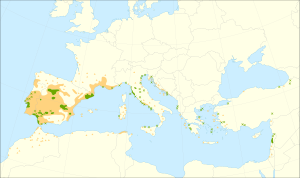 |
|
| Distribution map | |
The stone pine, also known as the Italian stone pine or umbrella pine, is a type of pine tree. Its scientific name is Pinus pinea. This tree is originally from the Mediterranean region, which includes parts of Southern Europe and the Middle East.
People have used stone pines for a very long time because of their tasty pine nuts. They are also popular as ornamental trees in gardens and parks all over the world. For example, in places like coastal California, these evergreen trees are widely planted. The stone pine has even won an award called the Royal Horticultural Society's Award of Garden Merit for being a great garden plant.
Contents
Where Stone Pines Grow
Stone pines naturally grow in the Mediterranean forests, woodlands, and scrub areas. This includes countries in Southern Europe, Western Asia, and North Africa.
Stone Pines in Europe
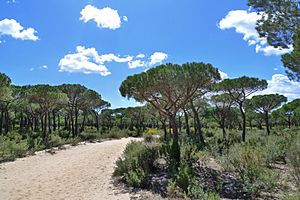
You can find stone pines in Spain, Portugal, France, and Italy. They also grow along the eastern coast of the Ionian and Adriatic Seas in Croatia and Albania. In some parts of northern Italy, large parks by the sea are filled with these pine trees.
In Greece, there's a big stone pine forest in western Peloponnese at Strofylia. This forest is about 8 kilometers (5 miles) long and has tall stone pines mixed with other pine trees. Another place in Greece is Koukounaries on the island of Skiathos, where stone pines grow between a lagoon and the Aegean Sea.
Stone Pines in Asia and Africa
Stone pines are also found in Western Asia, including Turkey, Syria, Lebanon, and Israel. In North Africa, they grow in Morocco and Algeria.
Stone Pines in South Africa
In the Western Cape Province of South Africa, it's believed that French settlers called Huguenots brought the seeds with them in the late 1600s. The tree is known as kroonden in the Afrikaans language there.
What Stone Pines Look Like
The stone pine is an evergreen tree, meaning it stays green all year. It can grow taller than 25 meters (82 feet), but usually, it's about 12 to 20 meters (39 to 66 feet) tall. When the tree is young, it looks like a bushy ball. As it gets older, its branches spread out to form a wide, flat top that looks like an umbrella. This top can be more than 8 meters (26 feet) wide!
The tree's bark is thick and reddish-brown. It has deep cracks that form wide, vertical plates.
Leaves of the Stone Pine
The leaves of the stone pine are like needles and are a mid-green color. They usually grow in pairs and are about 10 to 20 centimeters (4 to 8 inches) long. Sometimes, they can be even longer, up to 30 centimeters (12 inches).
Young stone pine trees (up to 5-10 years old) have different leaves. These "juvenile" leaves are single (not paired) and a blue-green color, about 2 to 4 centimeters (0.8 to 1.6 inches) long. The adult leaves start to appear when the tree is about 4 or 5 years old and completely replace the juvenile leaves by the time the tree is around 10 years old.
Pine Cones and Seeds
The cones of the stone pine are wide and oval-shaped, about 8 to 15 centimeters (3 to 6 inches) long. They take a very long time to grow and ripen – about 36 months! This is longer than any other pine tree.
The seeds inside the cones are called pine nuts. They are large, about 2 centimeters (0.8 inches) long, and pale brown. They have a thin, papery wing that easily falls off. This wing doesn't help the seeds fly far in the wind. Instead, animals (and humans!) usually help spread these seeds.
How People Use Stone Pines
Food from Pine Nuts
People have been growing Pinus pinea for at least 6,000 years because of its delicious pine nuts. These nuts have been traded for a very long time. The tree has been grown around the Mediterranean Sea for so long that it now grows wild in many places outside its original home.
Stone Pines for Beauty
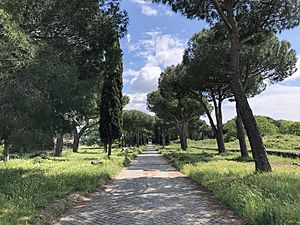
The stone pine is a famous symbol of Rome, Italy. It was first planted there during the time of the Roman Republic. Many old Roman roads, like the Via Appia, were (and still are) lined with these beautiful trees.
During the Ottoman period, stone pines were planted on the hills of the Bosporus strait in Istanbul, Turkey, to make the area look nice. In Italy, the stone pine has been an important part of beautiful landscapes since the Italian Renaissance garden period.
Since the 1700s, P. pinea has been planted as an ornamental tree in other parts of the world with a Mediterranean climate, like South Africa, California, and Australia. In South Africa, it has even spread beyond cities and is now considered an invasive species in some areas. It is also planted in western Europe and parts of the United States.
Small stone pine trees are used for bonsai, which is the art of growing miniature trees. Young seedlings, about 20 to 30 centimeters (8 to 12 inches) tall, are sometimes sold as small Christmas trees for tables.
Other Uses of the Tree
Besides pine nuts, stone pines also provide other useful products. Their resin can be collected, and their bark can be used to get tannin, which is used in leather making. The empty pine cones can even be used as fuel.
Stone pines are also widely planted around the Mediterranean Sea to help the environment. They are used to strengthen coastal dunes, prevent soil erosion, and protect farms near the coast.
Pests Affecting Stone Pines
A bug called the Western conifer seed bug (Leptoglossus occidentalis) was accidentally brought to northern Italy in the late 1990s from the western USA. This bug has since spread across Europe and become a problem. It feeds on the sap of young pine cones, which makes the developing seeds shrivel up and not grow properly. This bug has destroyed most of the pine nut seeds in Italy, which is a threat to the stone pine in its native areas there.
Gallery
-
Pines on Via Appia Antica
See also
 In Spanish: Pino piñonero para niños
In Spanish: Pino piñonero para niños



